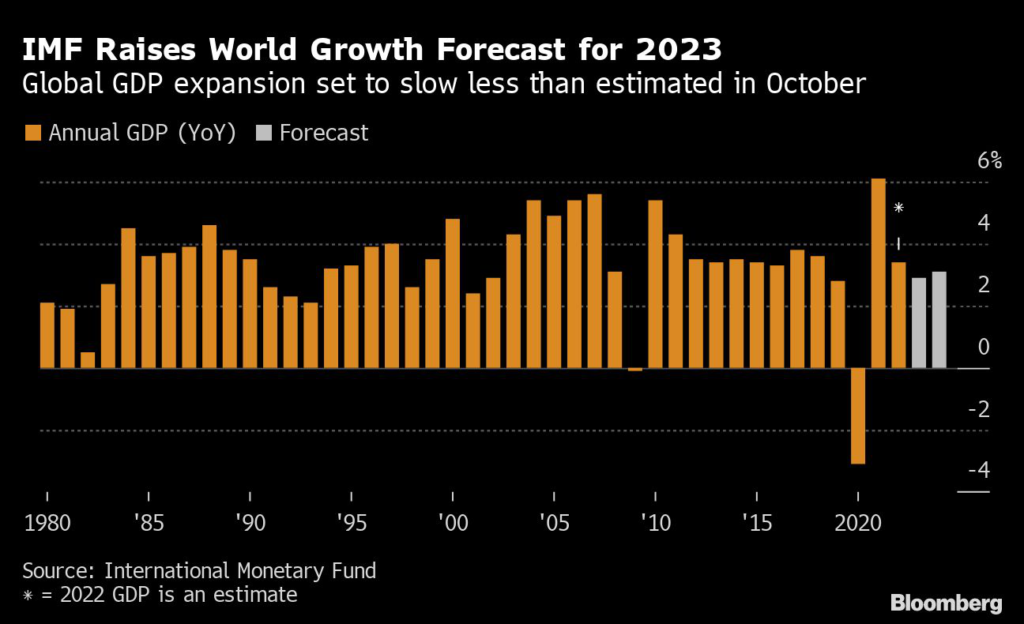The International Monetary Fund sees a “turning point” for the global economy as it raised its growth outlook for the first time in a year, with resilient US spending and China’s reopening buttressing demand against a litany of risks.
(Bloomberg) — The International Monetary Fund sees a “turning point” for the global economy as it raised its growth outlook for the first time in a year, with resilient US spending and China’s reopening buttressing demand against a litany of risks.
Gross domestic product will likely expand 2.9% in 2023, 0.2 percentage point more than forecast in October, the fund said Tuesday in Singapore in a quarterly update to its World Economic Outlook. While that’s a slowdown from a 3.4% expansion in 2022, the IMF said it expects growth will bottom out this year before accelerating to 3.1% in 2024.
Central banks’ interest-rate hikes and Russia’s invasion of Ukraine will continue to weigh on economic activity this year amid a protracted inflation crisis, the Washington-based institution said.
While the slight upgrades are hardly cause for celebration, the IMF’s latest messaging signals a tonal shift as the fund’s top officials spent much of last year warning about the risks of widespread recession.
The fund sees world consumer-price increases slowing to 6.6% this year, 0.1 percentage point higher than the October projection, following 8.8% in 2022. It forecast further slowing to 4.3% in 2024. Inflation rates are expected to be lower in about 84% of countries in 2023 than in 2022.
“The outlook is not worsened this time around, which in itself is good news,” chief economist Pierre-Olivier Gourinchas said. The fund cut its 2023 outlook three times last year. “But it’s not enough. There are still some challenges to get on our way to a sustainable recovery that is broad and long-lasting.”
The fight against inflation is not yet won: Monetary policy will need to remain contractionary, and some countries will need to tighten further before there’s a slowdown in broad measures of cost of living increases, Gourinchas said in a briefing.
Downside risks include China’s recovery stalling, the war in Ukraine escalating, and more emerging and developing economies entering debt distress.
Inflation could also prove more persistent. Financial markets may become volatile, and international tensions spurred by Russia’s aggression could cause the global system to fragment, hampering cooperation between nations.
Yet the risks are more balanced than in October, Gourinchas said. One upside risk is stronger consumption, particularly in services, fueled by pent-up demand from tight labor markets and government pandemic fiscal support. Conversely, inflation could fall faster than expected amid the shift in spending to services, allowing central banks to tighten less.
“We are far from having won the fight against inflation,” Gourinchas said in an interview Tuesday with Bloomberg Television’s Rishaad Salamat. “We’ve had a few good prints. It’s encouraging. It’s in the right direction.”
Growth Estimates
- The fund raised its 2023 growth forecast for advanced nations marginally to 1.2%, 0.1 percentage point higher than previously foreseen and less than half the 2.7% expansion in 2022.
- In that group, the British economy is an outlier, expected to contract 0.6%.
- The US is expected to grow 1.4%, 0.4 percentage point more than in the prior projection, amid resilient domestic demand.
- The IMF sees a “narrow path” where a US recession can be avoided in 2023, despite the unemployment rate rising to about 5.2% by next year from 3.7% this year, Gourinchas said.
- The biggest upgrade was for the Russian economy, which the fund now predicts will expand 0.3% compared with a contraction of 2.3% seen in October.
- The current level of the oil-price cap set by Group of Seven nations isn’t expected to significantly affect export volumes of Russian crude, with trade continuing to be redirected from sanctioning to non-sanctioning countries, the IMF said. The nation also is being helped by its fiscal-stimulus measures, Gourinchas said.
“We’re well away from any kind of global recession marker,” although the risks materializing could change that, Gourinchas said.
The IMF boosted its forecast for emerging-market and developing economies, saying they will grow 4%, a 0.3 percentage-point upgrade from October and compared with 3.9% for 2022. It raised the estimate for China’s expansion by 0.8 percentage point to 5.2%.
China and India will account for about half of world growth in 2023, Gourinchas said.
The IMF’s slightly more upbeat tone contrasts with a more dire view from its sister Bretton Woods institution, the World Bank. The development lender on Jan. 10 slashed its growth forecasts for most countries and regions, and warned that new adverse shocks could tip the global economy into a recession.
Gourinchas said that part of the difference is explained by the IMF’s use of purchasing-power-parity weights, which give a greater emphasis to emerging-market economies, differing from the World Bank’s use of market-based exchange rates.
The World Bank is also more pessimistic than the IMF on growth in advanced economies and European economies, he said.
–With assistance from Michelle Jamrisko and Clarissa Batino.
(Updates with additional comments throughout.)
More stories like this are available on bloomberg.com
©2023 Bloomberg L.P.










